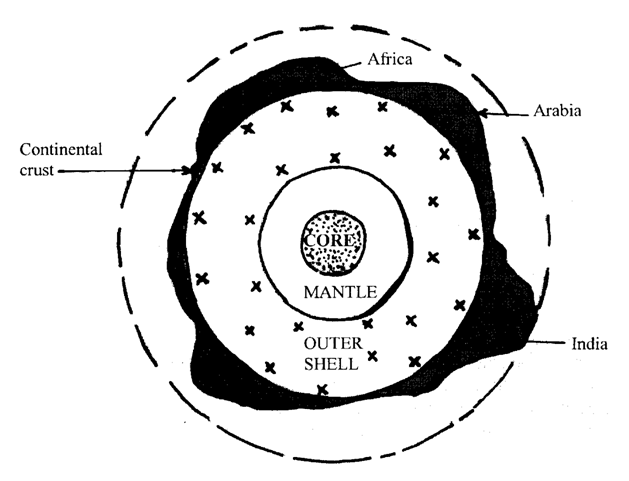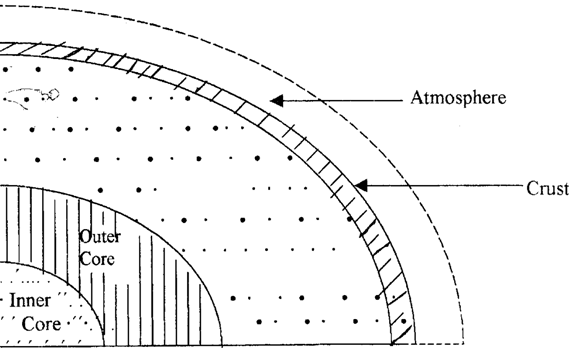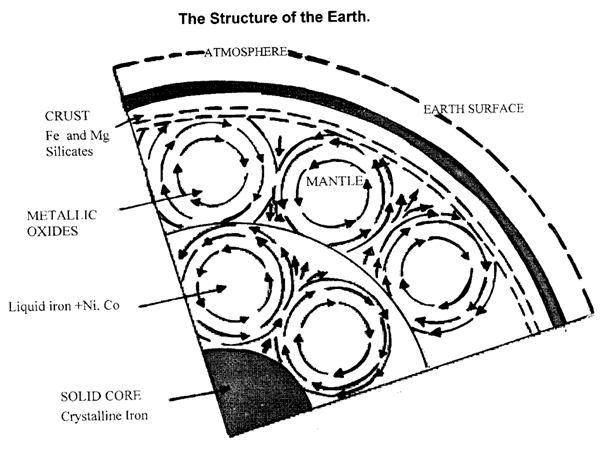COMPOSITION OF THE EARTH
The constituents (composition) of the earth could be summarised as:
- The atmosphere,
- The lithosphere,
- hydrosphere, and
- biosphere.
The Atmosphere
The word atmosphere is derived from two Greek words meaning " vapour" and "sphere" The atmosphere is composed of the gases, or vapour envelope which surrounds the earth. The earth's atmosphere has a number of characteristics, which include: Pressure, Weight, Density, and Temperature. The atmosphere is a mixture of gases called air. Nitrogen forms 4/5"1 of the total air of the atmosphere. Oxygen forms only 1/5111 of the total air of the atmosphere. There are also other types of gases within the atmosphere. But those appear in small quantities. For example, Carbondioxide and argon.
There is also water vapour in the atmosphere. Water vapour enters the atmosphere as a result of evaporation at the earth's surface and leaves it as precipitation, i.e. in form of rainfall, snow, hailstone, mist, among others after condensation has taken place. The average time spent by water vapour molecules in the atmosphere is only a few days. Its concentration varies considerably from one air mass to another. Water vapour plays an important part in the heat balance of the atmosphere.
Carbondioxide normally forms a very small part of the atmosphere gases (about 03%), the most important gases being nitrogen (78%) and oxygen (21%). Carbondioxide dissolves easily in water as the temperature increases, so that sir passing over a warm sea tends to contain a higher concentration of coy than that which passes over a cold water region. The burning of industrial fuel also causes light variations in the levels of Carbondioxide concentration.
Other materials present in the atmosphere include dust, pollen, salt from sea sprays, and the by-products of fires and industry (carbon, sulphurdioxide, ammonia, carbonmonoxide). Many of these contribute greatly to the pollution of the atmosphere. At the same time, they may help to facilitate the process of cooling and condensation where local environmental conditions permit so.
The other important component of the atmosphere is temperature. Temperature of the atmosphere decreases with height (altitude). For example, from the ground surface to between 10-18 km, temperature decreases at the rate of about 6°C per km. This layer is called "troposphere". The upper limit of troposphere is called tropopause.
Another characteristic of the atmosphere is pressure. It is important to note that, the atmospheric pressure also decreases with height, and this is roughly estimated at a factor of 10 for every 16 km of height to about 110 km. But after about 110 km the rate of decrease slows down. For example, at 220 km, the density is only 1/9th of the sea-level weight.

The Lithosphere
The Lithosphere refers to the part of the earth commonly known as "the crust". It is composed of the outer skin (part) of the earth. The lithosphere consists of rocks and minerals. Beneath the crust of the earth are two further parts called the mantle and the core. The earth's crust (lithosphere) is the most accessible part of the earth's structure and the most important to man's survival as well as other millions of living things.
At the same time, it's the most complex. The knowledge of the lithosphere of the earth increases year after year and it is used to modify the theories about the former's interior. Until recently, the earth's outer crust layer was thought to be composed of rafts of SIAL (light rocks rich in silica and alumina) which floated on a "sea" of sima (heavier rocks rich in silica and magnesia). But recent studies have revealed that large areas of the outer crust layer are made up of basaltic rocks, which form the ocean bed in the central parts of the Atlantic and Indian oceans. Similar rocks form the ocean bed of the waters around the Antarctica.
The earth's crust consists essentially of rocks and minerals of varying physical, chemical and mineralogical properties and origins. Although rocks are and minerals are primarily the concern of the geologists, geographers need to know about them so that they can understand their influence on landforms and landscapes as well as the connection between them and various natural resources such as minerals, soil and water.
Rocks of the lithosphere as such can be distinguished by their mineralogical composition among other things. They are also commonly classified according to their origin and this gives us three categories of rocks. They include Igneous rocks, " Sedimentary rocks, and Metamorphic rocks.
Igneous rocks are sometimes called " fire formed" rocks. They are formed by the cooling down of molten rock (magma) derived from deep in the earth's interior through a process called volcanicity. As a result of cooling in different parts of the earth's crust, volcanic or igneous rocks are of different types, reflecting the environment in which they were formed. In general, igneous rocks formed at great depths are called plutonic (intrusive). Between plutonic and extrusive rock types are hypabyssal rock types.
Sedimentary rocks are formed from sediments or materials worn from an original parent rock. The sediments are then transported and later deposited together with chemically and physically formed materials. Sedimentary rocks are sub - divided according to origin and physical texture (textural) and mineralogical composition. Sediments may result from mechanical processes, particularly through the agents of erosion such as rivers, wind and ice from chemical precipitates or from organic action. Most sedimentary rocks were formed under the ocean or other large water bodies.
Metamorphic rocks are formed from sedimentary and igneous rock types. This occurs as a result of intense heat and pressure. Although all the rock types are known to occur at the earth's surface, some of them appear exclusively in particular portions of the earth crust. But in general, a section of the earth's crust from top to bottom consists of: a sedimentary layer - soils, sediment and weathered mantle. A layer of mostly granitic rocks, and a layer of mostly basaltic rocks.
This is the lower Crust and its bottom limit is the mohorovicia discontinuity, or Crust - mantle boundary of the denser layer below.

Hydrosphere
The hydrosphere is the liquid part of the earth as opposed to the solid or rock (lithosphere) portion, or the gaseous section (atmosphere) of the earth. Theoretically, the hydrosphere includes the water vapour of the atmosphere, the water in the oceans, seas, lakes and rivers and water present in the soil and rocks. The oceans and connected seas have been estimated to cover about 71% of the surface of the earth. Their average depth is about 3780 m so that their total volume is about 8680 km , Judging from the extent of sedimentary rock, vast areas which are now dry land once lay under the sea. Indeed, it seems probable that no spot on the earth's surface has been land throughout geological time.
The biosphere refers to the world of living organisms, which dwell on land, in water and in the atmosphere (air). These range from microscopic single - cell plants and animals to giant trees animals to giant trees and animals. Scientists estimate that about one million different species of animals and perhaps three thousand million species of plants have existed since life begun on the Earth. Yet the total mass of the biosphere at any living time is very small.
Living organisms have a number of common characteristics. They include: They can adapt to many different environments. Most are found in the interfaces, or boundary areas between the various spheres. The plant-soil interface is perhaps the most densely inhabited. They are essentially composed of organic compounds, or compounds containing carbon, unlike the rest of the earth's crust of which the main elements are oxygen and silican.
Structure of the Interior of the Earth
The surface layer of the continents is composed mainly of granitic rocks with a density of about 2.65-2.70. These rocks contain a large proportion of silica (si) and aluminium (al). They are therefore collectively known by the group name of Sial. This layer of Sial varies in thickness. On continents the layer can he extremely thick but over ocean floors, especially the pacific, the layer can be thin or even absent. On the surface of this layer, there are sediments produced by long periods of erosion and deposition.
Beneath the sial, there is a layer of denser rocks. The rocks consist mainly of Silica (Si) and Magnesium (Ma) and are therefore collectively known by the group name of Sima. These rocks, whose average density is about 2.9, sometimes appear on the surface as basaltic lava. These are the rocks which sometimes form ocean floors. Sial and Sima collectively form the Earth's crust. The overall thickness of the earth's crust has been estimated to range from 8-50 kilometres.
Beneath the crust, there is a layer of rocks known as the Mantle. These rocks have a relatively high density of between 3.0-3.3. They are in form of concentric shells and are mainly composed of Ferromagnesian Silicate minerals. There is a discontinuity between the rocks of the mantle and those of the crust. This is a boundary surface where there is a change in physical properties of rocks. This is known as Mohorovicic (Moho) discontinuity.
Geologists believe that the mantle is divided into two parts by a layer of less rigid and more plastic rocks. These are hot, weak and almost molten rocks. This layer is known as the asthenosphere. The layer is believed to have very high temperatures and is composed of rocks of high mobility compared to those above and below it. It is from this layer that the convective current that drives tectonic plates and causes earth movements comes. The magma that upwells to form various structural features is also believed to originate from this layer. The term lithosphere refers to the Crust (Sial and Sima) and upper Mantle. The following diagram shows a cross section through the outer layers of the earth.
Beneath the mantle lies the Core which is subdivided into two layers, namely, the outer core and the inner core. The outer core is believed to be liquid while the inner one is said to be totally solid. In general, the core is a region of extremely high temperature which may reach a level of about 3700°C. The dominant rocks are made up of Nickel (Ni) and Iron (Fe) hence collectively known by the group name of Nife. The inner core experiences immense pressure approximately of the order of 3.88 x 10 kg/cm . The depth between the surface of the earth and the inner core has been estimated to be approximately 6370 kilometres. The core is separated from the mantle by a boundary surface known as the Gutenberg discontinuity which is estimated to be at a depth of about 2900 kilometres The two diagrams shown below illustrate the main features of the Earth's structure, one shows a cross-sectional view and the other a vertical view.
Cross Sectional view of the earth's layered structure

Below is a vertical section through the earth's layered structure.

The structure of the Earth's interior has a vital link with the landforms that evolve on the surface of the earth. The interior of the Earth is a source of the various endogenic forces that have led to the formation of a variety of landforms in many parts of the world.
Continents the layer can be extremely thick but over ocean floors ‘especially the pacific ‘the layer thee sediments produced by long periods of erosion and deposition'
Beneath the Sial (si] and magnesium [ma]and are therefore collectively known by the group of name of Sima .These rocks ‘whose average density is about 2.9 ; sometimes appears on the surface as basaltic lava .these are the rocks which sometimes form ocean floors .The Sial and Sima form the earth's crust .The over all thickness of the earth's crust range from 8`-5o kilometers
Beneath rocks there is a la known as the mantle. These rocks They are in form of Have a relatively high density of between 3.03.3. They are in form of concentric shells and are mainly composed of Ferromagnesian silicate minerals. There is a discontinuity between the rocks of the mantle and those of the crust. This is a boundary surface where there is a change in physical properties of rocks ‘This is known as mohorovic (moho) discontinuity
Summary of composition of the earth
The earth consists of five parts: the first, the atmosphere, is gaseous; the second, the hydrosphere, is liquid; the third, fourth, and fifth, the lithosphere, mantle, and core, are largely solid. The atmosphere is the gaseous envelope that surrounds the solid body of the planet. Although it has a thickness of more than 1100 km (more than 700 mi), about half its mass is concentrated in the lower 5.6 km (3.5 mi). The lithosphere, consisting mainly of the cold, rigid, rocky crust of the earth, extends to depths of 100 km (60 mi). The hydrosphere is the layer of water that, in the form of the oceans, covers approximately 70.8 percent of the surface of the earth. The mantle and core are the heavy interior of the earth, making up most of the earth's mass.
The hydrosphere consists chiefly of the oceans, but technically includes all water surfaces in the world, including inland seas, lakes, rivers, and underground waters. The average depth of the oceans is 3794 m (12,447 ft), more than five times the average height of the continents. The mass of the oceans is approximately 1.35 quintillion (1.35 × 1018) metric tons, or about 1/4400 of the total mass of the earth.
The rocks of the lithosphere have an average density of 2.7 and are almost entirely made up of 11 elements, which together account for about 99.5 percent of its mass. The most abundant is oxygen (about 46.60 percent of the total), followed by silicon (about 27.72 percent), aluminum (8.13 percent), iron (5.0 percent), calcium (3.63 percent), sodium (2.83 percent), potassium (2.59 percent), magnesium (2.09 percent) and titanium, hydrogen, and phosphorus (totaling less than 1 percent). In addition, 11 other elements are present in trace amounts of 0.1 to 0.02 percent. These elements, in order of abundance, are carbon, manganese, sulfur, barium, chlorine, chromium, fluorine, zirconium, nickel, strontium, and vanadium. The elements are present in the lithosphere almost entirely in the form of compounds rather than in their free state. These compounds exist almost entirely in the crystalline state, so they are, by definition, minerals.
The lithosphere comprises two shells-the crust and upper mantle-that are divided into a dozen or so rigid tectonic plates (see Plate Tectonics). The crust itself is divided in two. The sialic or upper crust, of which the continents consist, is made up of igneous and sedimentary rocks whose average chemical composition is similar to that of granite and whose density is about 2.7. The simatic or lower crust, which forms the floors of the ocean basins, is made of darker, heavier igneous rocks such as gabbro and basalt, with an average density of about 3.
The lithosphere also includes the upper mantle. Rocks at these depths have a density of about 3.3. The upper mantle is separated from the crust above by a seismic discontinuity, called the Moho, and from the lower mantle below by a zone of weakness known as the asthenosphere. Shearing of the plastic, partially molten rocks of the asthenosphere, 100 km (60 mi) thick, enables the continents to drift across the earth's surface and oceans to open and close.
The dense, heavy interior of the earth is divided into a thick shell, the mantle, surrounding an innermost sphere, the core. The mantle extends from the base of the crust to a depth of about 2900 km (1800 mi). Except for the zone known as the asthenosphere, it is solid, and its density, increasing with depth, ranges from 3.3 to 6. The upper mantle is composed of iron and magnesium silicates, as typified by the mineral olivine. The lower part may consist of a mixture of oxides of magnesium, silicon, and iron.
Seismological research has shown that the core has an outer shell about 2225 km (1380 mi) thick with an average density of 10. This shell is probably rigid, and studies show that its outer surface has depressions and peaks, the latter forming where warm material rises. In contrast, the inner core, which has a radius of about 1275 km (795 mi), is solid. Both core layers are thought to consist largely of iron, with a small percentage of nickel and other elements. Temperatures in the inner core may be as high as 6650°C (12,000°F), and the average density is estimated to be 13.
The Structure of the Moon
The Moon, our fellow-traveler in space, has a diameter half that of the Earth's core, and it rotates around the Earth, as all the planets rotate around the Sun, under the force of gravity. Moonquakes of very low energy are caused by land tides produced by the pull of Earth's gravity, and, from analysis of moon- quake data, scientists believe the Moon has two layers: a crust, from the surface to 65 kilometers depth, and an inner, more dense mantle from the crust to the center at 3,700 kilometers. The crust is presumed to be com- posed primarily of rocks containing feldspar, calcium aluminum silicate, and lesser pyroxene, iron and magnesium silicate; the crust also contains basalt in the mares, which contains less iron and more titanium than earth basalt. The mantle is thought to be made up of calcic peridotite, containing both pyroxene and feldspar.